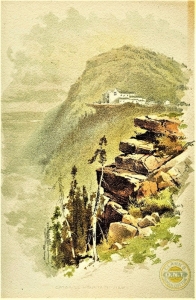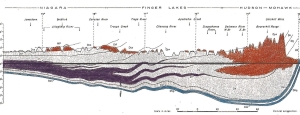Noah’s flood and the Catskill Delta
On the Rocks; 2020
Robert and Johanna Titus
The two of us have been lifelong scientists. For both of us, our interests in science date back to our early childhoods. For both of us the vast antiquity of earth history and the evolution of life have always been givens. Our opinions count: our lifetimes of studies have never uncovered anything even remotely doubtful about the old Earth theories that underpin our sciences. We have never ever been puzzled by finding anything the least bit questionable about this scientific worldview. But we have long known of the opposition to these views generated from within the Christian fundamentalist community. It dates back to 1859 when Charles Darwin published his book about evolution. That opposition has become more institutionalized in recent years with the establishment of the Creation Museum and the Ark Encounter theme park, both in Kentucky. Its views are widely circulated in some Christian home schooling programs. Our recent columns have been outlining our responses to what is called “young earth creationism.” We continue on that theme today. Defending our sciences has always been important to us — and always will be.
Let’s take you to the Mountain House Hotel ledge, high atop the Catskill front. See our first picture. We are guessing that virtually all of you have been there, perhaps many times. What you probably don’t know is just how thick the stratified rocks beneath that ledge are. Take a look at our second illustration. It is a cross sectional view of Catskills stratigraphy. It was done by our friend, the late Dr. Don Fisher of the New York State Museum. It is based on his lifetime study of Catskills stratigraphy. Don didn’t do the work alone; he was joined in this endeavor by scores of other professional geologists. Earlier generations of geologists preceded Don and all this work is being carried on today by a younger generation of researchers. In short, this is well documented science.

There is quite a story here. The thickest strata are on the east (right) and the strata thin to the west (left). You can make out the Hudson Valley on the far right and next to that is the Catskill Front. The thickest stratigraphy lies right at the top of the Catskill Front. Don estimated it at being nearly two miles thick there. If you get a chance to visit the ledge, then look down and imagine all the stratigraphy that lies beneath your feet. It is more than just a little awesome to fully understand this. But it is something that all of us should know about.

There are generations of oceans down below. The black and the gray at the bottom are limestones and shales of the Helderberg and Marcellus seas. Above them (dotted) are the strata of the Hamilton Sea. We have described all of these in recent columns and made the case for how much time each one of them represents. Today’s column is about the reddish-brown unit in the upper right. It makes up almost all of the stratified rock outcrops that we see as we travel about in the Catskills. These are the strata of the famed Devonian aged Catskill Delta.
We know these rocks well. We have been studying them for decades. When we visit their outcroppings, we see petrifactions from within the old delta. We see a lithic mosaic of delta habitats. We gaze at old riverbanks and channels. We recognize floodplain soils and floodplain swamps. We visit the shallow ponds that are so common on all deltas. From time to time we see the fossils of the primitive trees, shrubs and weeds that grew upon this ancient landscape. We have found fossil freshwater fish that lived in delta waters and we have read about the many invertebrates who lived in these lands. We know the climate’s rainfall had been seasonal back then and we have even seen petrified charcoal left behind by dry season forest fires. We appreciate the delta all the more because we understand that it displays some of the oldest forest ecology known on Earth, something called the Gilboa fossil forest. Not surprisingly, these are all primitive land plants. All in all, this may well be the finest view of a Devonian landscape in all the world.
Look again at our second illustration. These are the rocks we have been speaking of in our most recent columns. There are miles of strata here. It is an enormous unit of rock. It is an important unit of rock. It could not have been and was not deposited by the waters of Noah’s flood!
Contact the authors at randjtitus@prodigy.net. Join their facebook page “The Catskill Geologist.” Read their blogs at “thecatskillgeologist.com.”





